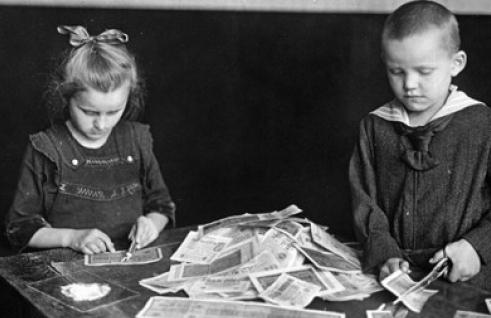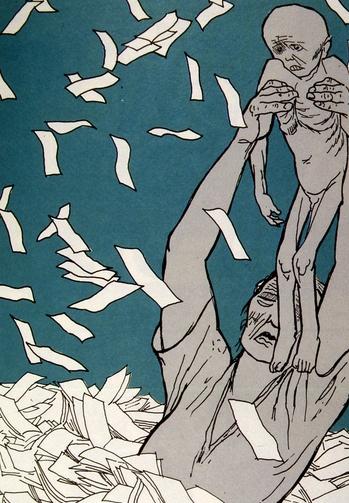As everyone who has studied political economy knows, money is a commodity, albeit a very specific one. Many definitions came up with this concept, from highly scientific to humorous, but their essence does not change from this. Money, in the words of Marx, is a receipt for the right to exploit the labor of others. Moreover, as long as they are minted or printed, such exploitation will exist. And there will always be people who have more of them than others. And the fight for power is inextricably linked with the struggle for money. Mankind came up with equivalent units for their own convenience at the moment when commodity relations arose. In today's market, complicated by complicated international financial and credit relations, money depreciates in different countries. This phenomenon, depending on the degree of the process, is called differently: inflation, hyperinflation, default, stagnation, and even the complete collapse of the economy. What are the mechanisms of these processes?

Inflation
The purchasing power of any currency decreases over time. And the point is not even in the current Jamaican world monetary system based on floating rates - it only regulates the ratio of the value of various banknotes. If you evaluate how much, for example, the American dollar has lost its solvency over the past three to four decades, it turns out that we are talking about its multiple fall. The same is true with the Swiss franc or Japanese yen. The gradual depreciation of money is called inflation, the reverse process is called deflation, which economists also consider a negative phenomenon. The mechanism of these phenomena is quite simple. As the economy grows, there is more and more money in circulation, the values provided in exchange for them by the market are gaining consumer accessibility. All this is an engine for further development. Inflation within 2-3% is considered normal and even desirable.
Hyperinflation
As long as world currencies were provided with gold reserves, that is, during the period of the Genoa and Bretton Woods currency systems, inclusively, both the exchange rates and the prices remained relatively stable. Of course, crises and depressions occurred, sometimes very painful, but the dollar (and even a cent) remained in price, it was very difficult to earn it. But in countries that have lost their gold reserves (such as Germany after the defeat in the First World War), there was a rapid depreciation of money. This phenomenon was expressed in hundreds and even thousands of percent, and in the amount that recently amounted to capital, in a month you could buy a pack of cigarettes, or even a box of matches. Something similar happened to the former citizens of the suddenly collapsed Soviet Union. Such an avalanche depreciation of money is called hyperinflation. It is caused by a complete or widespread collapse of the financial system of the state, expressed in the uncontrolled printing of unsecured bank notes and bank notes by the Central Bank.

Default
This new term for our ear struck thunder in the blue in 1998. The state announced its inability to answer for debt obligations, both in the foreign economic sphere and within the country. This moment was accompanied by hyperinflation, but besides it, the citizens of the former Union felt other “charms” of default. The store shelves were empty immediately, people were eager to spend their savings as quickly as possible, while something else could be bought on them. Many enterprises went bankrupt, whose activities were to one degree or another related to the banking sector. Interest rates on loans soared to cosmic magnitudes. Engaging in anything other than resale has become unprofitable, then unprofitable, and finally simply impossible. Default is the depreciation of money caused by a complete loss of confidence in the national currency in the domestic and foreign markets. The reason for it is usually system errors in managing the country's finances. In other words, a default occurs when the government spends more money than the national economy can sustain. The depreciation of money in Russia, and then in other former republics of the USSR, had other reasons related to the general sharing (between those who had access to this process) of the wealth of a destroyed great country. A “classic” default occurred in Mexico (1994), Argentina (2001) and Uruguay (2003).

Inflation and devaluation
Rising domestic prices in countries with underdeveloped and inefficient production is directly related to the collapse of the national currency. If the percentage of goods consumed has a high import component, money will certainly depreciate. This is due to the fact that the purchase of all the necessities is made for world currencies, in particular, for US dollars, against which the rate of the national currency decreases. In countries that are less dependent on external supplies, with high levels of devaluation, inflation is observed only in the assortment of imported goods and that part of domestic goods in which foreign components are used in production.
The positive aspects of inflation ...
Inflation of even significant size has not only a destructive, but sometimes a healing effect on economic processes. Outpacing price increases encourages savings holders not to store rapidly melting stocks “in stockings”, but to put them into circulation, speeding up financial flows. Operators are leaving the market for whom the depreciation of money is a disastrous factor due to the low efficiency of their activities. Only the strongest, hardiest and most persistent remain. Inflation plays a sanitary role, freeing the national economy from unnecessary ballast in the form of weak enterprises and financial and credit institutions that are unable to withstand competition.
... and default
It may seem paradoxical that even the complete collapse of the national financial system is beneficial, but it also has a rational kernel.
First, the depreciation of paper money does not mean that other assets lose their value. Enterprises that have managed to maintain their production potential in the face of dire shocks are becoming objects of increased attention of foreign and domestic investors.
Secondly, a state that has declared insolvency is temporarily exempt from annoying creditors and can focus its efforts on the most promising sectors of the economy. Default is a great opportunity to start “from a white sheet”. At the same time, creditors are not at all interested in the death of a bankrupt, on the contrary, they tend to seek to help the debtor in order to later receive their money at least partially.
Forecasting
No matter how economists consoled ordinary citizens, pointing out the positive aspects of the crisis, the ordinary ordinary man is not encouraged by the prospect of loss of savings, a decrease in solvency and a general standard of living. He is concerned about the question of whether there will be a depreciation of money, under what conditions it will happen, and what to do to get out of this situation with the least losses. Well, the global, as well as national, economy, despite the apparent complexity, operates according to fairly simple principles. The stability of purchasing power and demand is influenced by factors that, if desired, everyone can learn from open sources. The size of GDP, gold and foreign exchange reserves, the value of external and internal debt, and most importantly, the dynamics of their changes - these macroeconomic parameters say a lot. Here everything is just like in an ordinary family: if more money is spent than it is earned, then sooner or later the creditor’s trust is lost, and collapse occurs. If the situation is the opposite - you can sleep peacefully.